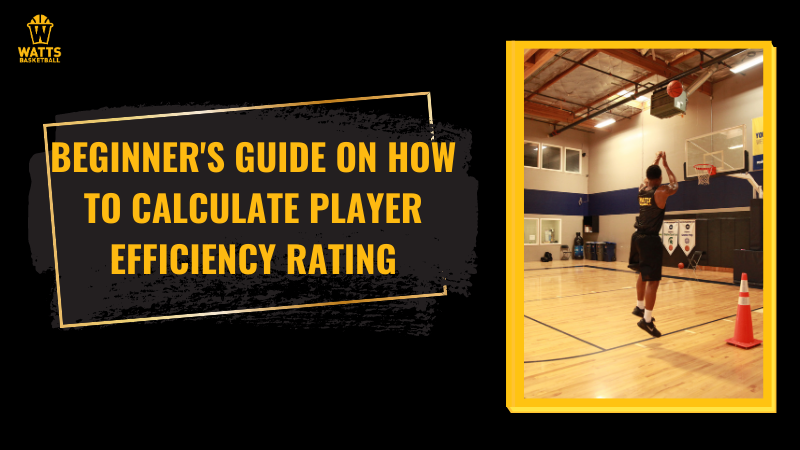Various metrics can assess a basketball player’s performance throughout a game, season, or career. Although excellence can be subjective and there’s no specific established way to judge an athlete’s performance, several analytics are widely used and accepted throughout the basketball world. For most, using these statistics can give the player, coach, and those concerned a glimpse of the player’s potential contribution or impact to the team. To understand the metrics, here’s a rundown on how to calculate player efficiency rating.
Different Basketball Analytics used in Evaluating Efficiency
Statistics drive the majority of professional sports leagues. The NBA can also be included in this category, as some of its awards are solely based on stats. Many analytics are made to measure a player’s impact in a game in a sport with many variables and different formulas.
The NBA measures individual efficiency in four ways: Efficiency (EFF), player efficiency rating (PER), offensive efficiency rating (OER), and defensive efficiency rating (DER). OER uses the number of points scored per shot taken(plus free throws). The number of points scored per 100 possessions determines the offensive rating. DER is a metric that estimates how many points a given player is likely to allow over 100 possessions. The paragraphs below explain the two most widely used methods.
Efficiency Metric (EFF)
A common, simple formula used in getting an average stat is the EFF (EFF). This metric is a quicker way for you to know a player’s Efficiency compared to PER. Efficiency pertains to the total value of a player to a basketball team. In this metric, per player statistics are recorded, particularly
- Points
- Rebounds
- Assists
- Steals
- Blocks
- Turnover
- Attempted Shot
One drawback of EFF is that it is highly concentrated on offenses, not much on defense, so one can’t derive the best evaluation on this part. To compute using the EFF metric, here’s the formula.
Basically, what we do here is to add up the positives (in white) minus the negatives (in yellow). For more detailed average stat, you can also do other variations; specifically, EFF per games played (EE/GP); EFF per game time (EFF/48 for NBA and EFF/40 for WNBA AND NCAA). To understand better, here’s a sample computation, or you can also use this online calculator.
A player has 28 points, 4 rebounds, 11 assists, 2 steals, 1 block, 8 missed field goals, 6 missed free throws, 7 turnovers, 10 games played, and 372 minutes played.
EFF = (28 + 4 + 11 + 2 + 1 – 8 – 6 – 7) = 23
EFF/GP = 23 ÷ 3 = 7.66
EFF/48 = (23 ÷ 72) x 48 = 15.33
EFF/40 = (23 ÷ 72) x 40 = 12.77
Do you want to be part of a program that will help elevate your efficiency as a player?
Player Efficiency Rating (PER)
Learning how to calculate Player Efficiency Rating (PER) has remained popular due to the use of analytics to evaluate player careers. Although PER is indeed very efficient, some players can find it confusing, so let’s work through it. In the late 1900s, John Hollinger, former Memphis Grizzlies Vice President of Basketball Operations and current author and basketball analytics expert for ESPN, created an all-in-one statistic called the Player Efficiency Rating. In his own words:
“The PER sums up all a player’s positive accomplishments, subtracts the negative accomplishments, and returns a per-minute rating of a player’s performance.”
It is a method of determining a player’s impact on the game by measuring their per-minute performance. Rather than judging a player solely on their stats, their PER is a much more thorough performance indicator. It details a player and compares their value to that of other players in the league. It generates a PER for each player based on in-game stats.
PER Formula
Derived from a highly complicated calculation designed to account for, among other things, the varying styles of play of different teams, PER scores, and EFF scores are not significantly different. Still, player rankings wouldn’t be the same in both metrics. Using a statistical point value system, the formula adds positive statistics and subtracts negative ones. Each player’s rank is then adjusted on a per-minute basis, comparing substitutes to starters in playing time debates. It is also tailored to the team’s speed. Finally, one number summarizes the players’ statistical achievements for the season. The formula for PER looks like this.
It looks complicated, but I also discovered a good post that discusses each component of the formulas and can teach you how to calculate player efficiency rating. Of course, if you want a more in-depth look at PER calculation, John Hollinger’s book “Pro Basketball Forecast” is available on Amazon.
PER Reference Guide
Here’s a list of PER stats and what they typically represent for a player’s career in the NBA. The list continues to classify players right down to a 0-9 PER, which usually indicates that they are not cut out for the league. The average PER in the league is 15.0. The list of PER stats above provides average fans with a perspective for what category of PER is required to achieve specific objectives in NBA history. The highest PERs in history do belong to some of the greatest players. The top three are Michael Jordan, Lebron James, and Anthony Davis.
The main factor there are a lot of methods to evaluate efficiency is that each rating has flaws. Except for DER, all of these ratings are highly based on offenses. Likewise, DER is challenging to monitor for individual performances and is dependent on teammates’ defensive performance. This is a result of defense being difficult to track statistically.
Learning How to Calculate Player Efficiency Rating Aids in Measuring Game Performance
Advanced analytics, designed to determine a player’s Efficiency while on the court, are among the most important sports innovations. It provides a more in-depth understanding of a player’s overall impact on game outcomes. These metrics can tell you a lot about what players have done in the past and the present, and they provide the most useful method of comparing players across eras. The goal of basketball analytics is to find a single statistic that can assess a player’s worth to a team.

